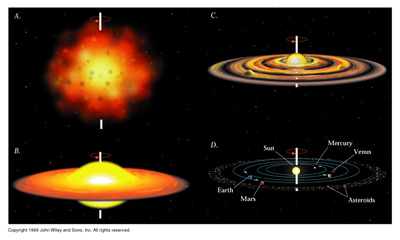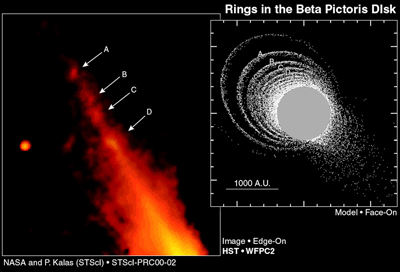Translated in Romanian  as well. as well.
Everything has a beginning, and our story begins
when the cloud that was the Solar Nebula began to
contract. All stars exist in islands called
galaxies, and
galaxies contain old and new
stars as
well as clumps of dust clouds. These clouds contain
mostly hydrogen and some heavier metals (any
elements that are heavier than helium is considered
a metal by Astronomers). As we will learn the the
Sun section,
stars create their energy by a process
called fusion. When a
star ends its life, it
explodes in a tremendous phenomenon called a
supernova. A
supernova has so much energy that heavy
metals are formed - metals like iron and gold. These
elements "seed" surrounding hydrogen clouds so that
newer
stars will contain more heavy elements in
their atmospheres.
It is believed that for a
system of planets to form around a
star during cloud
contraction the cloud must contain heavy elements.
The image below demonstrates how our Solar System
was formed:

For the cloud to begin contraction, two
conditions must be met:
- Jean's Mass - the cloud must contain a
certain amount of mass that depends on...
- Jean's Length - if the cloud of a certain
mass is also a certain diameter, contraction
will begin
 |
Click the image on the left for a video
of a simulated formation of a system of
planets. This particular simulation
demonstrates the Solar Nebula Hypothesis -
the formation of our Solar System (video
care of
Swinburne Astronomy Online). |
Jean's Mass and Jean's Length are an advanced
type of
Stellar Astrophysics that will not be
covered here, but a simple definition is that when a
cloud contains a certain amount of debris and is a
certain size, the likelihood of cloud contraction is
high. But if a cloud exists happily at a certain
size, how can it begin contraction? The answer is
outside influence:
- Surrounding
supernova can generate
shockwaves that will affect the debris in a
nearby cloud - if the cloud is shocked enough
and debris is forced inward, contraction can
begin
- The natural rotation of the
galaxy can
slowly affect the structure of a cloud
- Density Waves - a theory that explains the
spiral structure of
galaxies - can also
stimulate these clouds
 |
This image from the
Hubble Space
Telescope shows a solar nebula, evidence to
support the Solar Nebula theory. This is
called a protoplanetary disk, or proplyd.
This proplyd lies at the heart of the Orion
Nebula along with dozens of other proplyds.
The darker area is the dense molecular cloud
while the proto-star (a
star that is hot,
but not hot enough to initiate fusion) is
the glow in the center. |
While the above image shows the early stages of a
system of planets, there are
stars that already have
formed planetesimals. The image below is of Beta
Pictoris:

This image clearly shows that this
star has 4
distinct rings. These rings will eventually coalesce
into solid bodies called planets. Our Solar System
has three distinct features as a direct result of
its formation:
During formation, these bodies that would
form planets are called planetesimals.
They begin their life as very small clumps of
debris, but as the Solar Nebula contracts, a
natural disk shape forms (a result of the
conservation of energy - a natural phenomenon).
These planetesimals assume their
orbits and
gather surrounding debris in a process called
sweeping. Because the terrestrial planets
form close to the proto-sun (the
Sun at this
point has not initiated fusion) the warmth melts
away any ices so rocky planets form. The Gas
Giants are at a greater distance and much of the
ice and gas remains.
During the sweeping process, the protoplanets
undergo another natural phenomenon called
chemical differentiation, a process in which
heavy elements sink towards the center of the
object while the light elements remain closer to
the surface. This is the reason for the internal
structures of the planets are dense, rocky and
heavy.
During all of this planet evolution, the
proto-star in continuing to contract until it
reaches a magic
temperature resulting from a
process called Kelvin-Helmholtz contraction
(as an object of mass is compressed, it
generates heat as a result of the compression),
the proto-sun will "ignite." The
temperature required for fusion to occur is 106 K
- or 999,726.85º C.
When the
Sun
ignites, the result is a shock wave called T
Tauri Wind. This wind is strong enough to
blow away any gas in the inner Solar System, but
not strong enough to strip away the thick
atmospheres from the Gas Giants.
The
asteroid belt creates a natural boundary
between the terrestrial and gaseous planets, but
it could have been a planet. The gravity
influence of
Jupiter is believed to be enough to
prevent to
asteroids from coalescing into a
planet. Instead, individual
asteroids are
knocked out of
orbit and either put into
elliptical
orbits near
Earth - called Near
Earth Objects - or captured by
Jupiter to become one
of its many moons.
The residual debris of our Solar System is
locked in two regions:
- The Kuiper Belt - are area containing
rock/ice bodies beyond the
orbit of Pluto
- The Oort cloud - a cloud containing
"dirty ice" well beyond the
orbit of the Kuiper Belt (comets are from the Oort Cloud)
It takes millions of years for this
process to occur. And this was a long time
ago:
- The
Earth is about 4.56 billion
years old - that is the
Earth as it was
already formed
- Our
Sun is also only 4.5 to 5
billion years old
The
Sun is considered an average,
middle-aged
star. Its safe to say that
there is still at least another 4
billion years before the
Sun enters the
Red Giant phase. Details on a
stars
evolution will be covered in the
stars section.
Back to Top |

